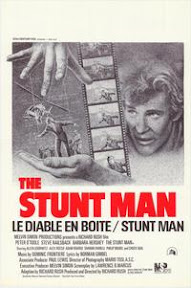 A fugitive dodges cops outside a convenience store, dashes through the woods and finds himself on a bridge. An old car -- really old -- races across. A helicopter hovers nearby. Though we haven't seen it, the car has gone into the water, and the man inside has drowned. He was a stunt double for the star of a movie filming there, and now the fugitive (Steve Railsback) will double for the stunt man so the director, Eli Cross (Peter O'Toole), can cover up the fatality and keep the sheriff (Alex Rocco) off his back.
A fugitive dodges cops outside a convenience store, dashes through the woods and finds himself on a bridge. An old car -- really old -- races across. A helicopter hovers nearby. Though we haven't seen it, the car has gone into the water, and the man inside has drowned. He was a stunt double for the star of a movie filming there, and now the fugitive (Steve Railsback) will double for the stunt man so the director, Eli Cross (Peter O'Toole), can cover up the fatality and keep the sheriff (Alex Rocco) off his back.Cameron, our fugitive, is immersed in a fantasy of moviemaking. He is put through his paces in insanely long takes and successions of stunts that look like no realistic notion I've had past childhood of how movies are filmed. If you seek out Richard Rush's film as an expose of the movie business or the director's art, turn back. The year is 1980 and Cross is shooting a World War I epic. Directors were doing some insane things around that time, but not that insane. The fantastical nature of the project (I don't recall even hearing the film's title) made me worry that it would all prove to be an "Owl Creek Bridge" scenario, especially since everything, including the American advertising art, urges us to treat Cross as a Satan figure. As the plot circles back to the beginning and Cross uses Cameron to restage the fatal car stunt, you're supposed to question whether the director really wants to see Cameron die. Cross seems to envy Cameron's war experiences, while Cameron, our archetypal Vietnam veteran, probably questions the reality of everything around him, not just the fake war on the film set. To set such a personality loose amid the purposeful unreality of filmmaking, especially while we don't know why he's a fugitive, is an ingenious high-concept scenario, but while it invites interpretation as some hell of Cameron's disordered mind, it can also be seen as a quest-like scenario designed to reintegrate the troubled outsider into society. Cross latches on to Cameron's statement that "If you want to see Thanksgiving, assume that the other guy's trying to kill you." He exploits Cameron's paranoia to a degree to prod him into furious action, but by the end he also seems to have tried to wean the stunt man off his fear and suspicion, or so he claims. Sometimes making a movie is just making a movie.
It doesn't quite hang together and it probably isn't meant to, but the exuberance of Rush's direction and O'Toole's performance sweep aside most questions or objections. Peter O'Toole is not quite my vision of a Seventies director gone overboard -- that might actually look more like Steve Railsback -- but to the extent that Eli Cross represents the archetype of the capriciously godlike movie director rather than Rush's own peers, O'Toole is right for the job. Railsback himself is always going to be Charles Manson for me, but Cameron is a role well-suited to his typecasting. He only goes wrong in the two scenes in which he expresses full-blown rage: his revelation of his crime and his final protest against being underpaid by Cross. Those moments don't seem consistent with the character we've seen until then, but were most likely expected of a Nam vet on film. While the ending left me scratching my head a little, I don't really hold it against the movie. The Stunt Man strikes me as a film I can watch again a year from now and find significances I missed the first time. If I can recommend it to myself for a rewatch, I guess I can recommend it to you.
FanOfMovies123 uploaded the trailer to YouTube:
3 comments:
I keep going back to this one - one of O'Toole's best characters.
The film was shot in San Diego, around (and on top of) the same hotel that was at the end of SOME LIKE IT HOT.
You should watch Richard Rush's documentary on the making of THE STUNT MAN, which was on the second disc of Anchor Bay's 2-disc set. Also, there are some very fascinating documents available as DVD-ROM supplements on the same set, including treatments and notes dating back to 1971, when Rush first tried to get this project off the ground -- the same year Corman's VON RICHTHOFEN AND BROWN was released, tying in with what you said about the sanity of making a WWI film in 1980 (THE STUNT MAN was actually shot in 1978 and didn't get a proper theatrical release until 1981, if I recall correctly). I like the movie a great deal but would've loved it if Laszlo Kovacs had shot it. FREEBIE AND THE BEAN, GETTING STRAIGHT, PSYCH-OUT and THE SAVAGE SEVEN are much more interesting visually than this movie, which could've used a little more of the "critical focus" style that Rush was so keen on discussing back in the day.
Nice; I'll have to check this out sometime.
Post a Comment